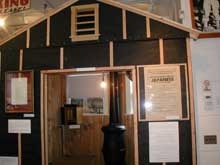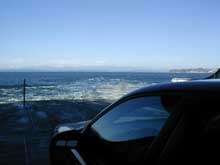11:00 a.m.
Here I sit in my rental car, mere yards from the water. I’m waiting for the Bainbridge Island Ferry in Seattle—I missed the last one by just seconds and the next one leaves in an hour.
Bainbridge Island is the place captured poetically in the book and movie, “Snow Falling on Cedars” (which means, come to think of it, that it snows in Seattle, at least sometimes).
A generation of Japanese Americans settled there in the early part of the 20th century. And, those Japanese Americans and their families were rounded up and railroaded to Manzanar, one of the nine concentration camps built by thr U.S. to imprison people of Japanese ancestry during World War II.
I’m taking the ferry to Bainbridge Island to see if I can capture some sense of the JA community there—both in the past and today. I have no idea what I’ll find. I know there’ve been some efforts underway to create a monument to JAs and their WWII internment, but I don’t know where those efforts are today.
It’s a sunny, beautiful, warm and crisp day in Seattle—the kind that belies the city’s rep for gray, cloudy, rainy weather. It’ll be a good ride to Bainbridge Island.
5 p.m.
It’s been a long day.
One of the good things about missing your ferry by moments is that you’re the first in line for the next boat, and therefore the first off on Bainbridge Island. It’s a beautiful, verdant place, and the ferry lets off right in the small downtown area, with a several-block area of quaint artsy shops.
I spent an hour window-shopping, and asked one shopowner if there was anything on the island to commemorate the Japanese Americans who were interned. She directed me to the post office down an alley, in front of which was a large wooden torii gate, one of those traditional Japanese gateways with the horizontal cross-piece on top.

The torii gate that will be part of the memorial to Japanese American internment on Bainbridge Island; the gate currently sits outside the island’s post office. (Photo by Gil Asakawa)
It had been created for use in a park and a memorial to be built across the bay from the downtown area, where the original dock used to be. That’s the dock that was used for the famous photos of Japanese Americans in 1942, walking with their belongings down the pier to the ferry that would take them first first leg of their trip to Manzanar, the famous camp in the eastern California desert.
It turns out the Bainbridge Island JAs were the first on the entire West Coast to be forced out of their homes. I shopped some more, then tried to drive to the place where the proposed park and memorial are planned. But I couldn’t find the site of the old docks, across from the current ferry dock.
So I returned to town and waited until 1 p.m., when the Bainbridge Island Historical Museum opened.

The Bainbridge Island Historical Museum includes a partial replica of a typical family’s single room “apartment” in an internmant camp barrack. (Photo by Gil Asakawa)
I had to take a 2 p.m. ferry back to Seattle, but I had enough time to look through the small display, which included quite a bit of information about the JA experience. I didn’t know, for instance, that the Caucasian newspaper editor portrayed by Sam Shepard in “Snow Falling on Cedars” was based on a real person.
The highlight was a collage of photos and information, including the text of interviews with survivors, about the JA history from its earliest immigration roots as lumber yard workers and strawberry farmers, to the post-war resurrection of the JA community on the island. It was a powerful, moving exhibit.
After taking the ferry back to downtown Seattle, I managed to find my way to the Wing Luke Asian Museum in the heart of the International District, Seattle’s Chinatown. The small, packed museum chronicled the history of all Asian groups in the area, and also had a touching section on Japanese Americans and internment.

Returning to Seattle on the Bainbridge Island Ferry. The nickname “Emerald City” is an apt description. (Photo by Gil Asakawa)
But the coolest parts were the newest displays, one about the stereotypes of Asian women and violence against women, and a thoughtful multimedia exhibit about Asian adoptees and the unique challenges they face.
A few blocks away, I checked out Uwajimaya, a huge Asian supermarket and food court, which is still run by the same family that started a small grocery store before WWII in Seattle’s now-rehabbed Japantown district (the current Uwajimaya takes up a block in the International District). It’s a virtual wonderland of Japanese goodies, but I restrained myself from buying my usual armsfull of snacks.
My backpack was too full anyway.
Now I’m waiting for my flight back to DIA—it’s been a whirlwind visit. Hope I can come back to Seattle and spend some time on my next trip.
*This article was originally published in NIKKEI VIEW: The Asian American Blog on April 22, 2005.
© 2005 Gil Asakawa







